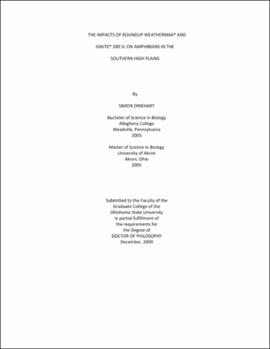| dc.contributor.advisor | Smith, Loren M. | |
| dc.contributor.author | Dinehart, Simon | |
| dc.date.accessioned | 2013-11-26T08:28:22Z | |
| dc.date.available | 2013-11-26T08:28:22Z | |
| dc.date.issued | 2009-12 | |
| dc.identifier.uri | https://hdl.handle.net/11244/7030 | |
| dc.description.abstract | Scope and Method of Study: Most playa wetlands in the Southern High Plains (SHP) region are embedded in cropland. SHP amphibians may encounter agricultural chemicals due to contaminated runoff or direct terrestrial exposure. I compared the acute and chronic toxicity of widely used herbicides Roundup WeatherMAX� and Ignite� 280 SL to larval New Mexico and Plains spadefoots (Spea multiplicata and S. bombifrons, respectively) from playas embedded in cropland or grassland. I also examined how the survival of juvenile New Mexico spadefoots and Great Plains toads (Bufo cognatus) housed on soil or moist paper towels was affected by exposure to environmentally relevant levels of a glufosinate-based (Ignite� 280 SL) herbicide and several glyphosate-based (Roundup WeatherMAX�, Roundup Weed and Grass Killer Ready-To-Use Plus�, Roundup Weed and Grass Killer Super Concentrate�) herbicides. The toxicity of glyphosate herbicides toward amphibians is thought to result primarily from surfactants. To increase knowledge on this subject, I investigated the histological impacts of a non-ionic surfactant (ADSEE 907�) on skin and gills of Spea spp. larvae. | |
| dc.description.abstract | Findings and Conclusions: No consistent difference in herbicide sensitivity was present among larvae from cropland and grassland playas. Toxicity data suggest that Ignite� 280 SL does not pose an immediate threat to larval New Mexico and Plains spadefoots. However, Roundup WeatherMAX� may pose a risk to larvae of these species. Roundup Weed and Grass Killer Ready-To-Use Plus� was highly toxic to New Mexico spadefoot and Great Plains toad juveniles. However, it is unlikely that amphibians will encounter this formulation under field conditions because this product is intended for lawn and garden use. When used properly, the agricultural herbicides tested (Roundup WeatherMAX� and Ignite� 280 SL) likely do not pose an immediate threat to juvenile New Mexico spadefoots and Great Plains toads under field conditions. Skin and gill lesions were not consistently more extensive among larvae exposed to ADSEE 907�. This unexpected histological response may have resulted from prior contaminant induced lesions, or tissue restructuring associated with metamorphosis. It is also possible that membrane narcosis (i.e., widespread disruption of cell membranes that negatively impacts cellular function) contributes to the toxicity of non-ionic surfactants toward amphibians. | |
| dc.format | application/pdf | |
| dc.language | en_US | |
| dc.rights | Copyright is held by the author who has granted the Oklahoma State University Library the non-exclusive right to share this material in its institutional repository. Contact Digital Library Services at lib-dls@okstate.edu or 405-744-9161 for the permission policy on the use, reproduction or distribution of this material. | |
| dc.title | Impacts of Roundup Weathermax and Ignite 280 SL on amphibians in the Southern High Plains | |
| dc.contributor.committeeMember | McMurry, Scott T. | |
| dc.contributor.committeeMember | Anderson, Todd A. | |
| dc.contributor.committeeMember | Smith, Philip N. | |
| dc.contributor.committeeMember | Haukos, David A. | |
| dc.contributor.committeeMember | Bidwell, Joseph R. | |
| dc.contributor.committeeMember | Davis, Craig A. | |
| osu.filename | Dinehart_okstate_0664D_10633.pdf | |
| osu.accesstype | Open Access | |
| dc.type.genre | Dissertation | |
| dc.type.material | Text | |
| dc.subject.keywords | amphibians | |
| dc.subject.keywords | glufosinate | |
| dc.subject.keywords | glyphosate | |
| dc.subject.keywords | ignite | |
| dc.subject.keywords | pesticides | |
| dc.subject.keywords | roundup | |
| thesis.degree.discipline | Zoology | |
| thesis.degree.grantor | Oklahoma State University | |
